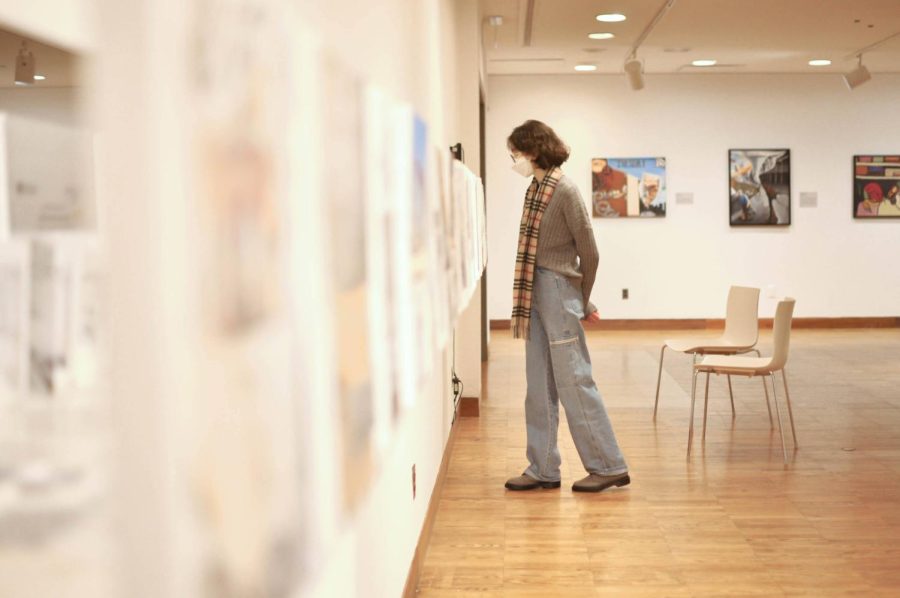Art exhibit empowers formally incarcerated voices
Valentina Fazio, junior in LAS, looks at the Mirror of Time installation by Nasrin Navab and other artists for the Reckless Law, Shameless Order Exhibit on Friday. The exhibit’s purpose is in giving an outlet for those formally incarcerated.
Feb 12, 2022
As art viewers gathered in the Krannert Art Museum, they were met with images of prison bars, tiny rooms and depictions of many individuals crammed close together in ICE detention centers. They saw the inhumane practices of prison systems.
The room was quiet as the audience reflected on the gallery. They observed how the colors of prison life – violence and policies – were felt by those who actually experienced them.
On Friday, a new art exhibit, “Reckless Law, Shameless Order: An Intimate Experience of Incarceration” premiered in the Krannert Art Museum’s Hood Classroom. Alongside the installation, there was a reception and a conversation with the featured artists.
The gallery features collaborative work from formally incarcerated artists. Through art, they shared their experiences in a way to make viewers think about how punishment is used to hold power over lives.
Nasrin Navab, one of the eight contributing artists, selected the art to be featured in the gallery. Other artists include Vincent Robinson, Kenneth Norton, Monica Cosby, Lauren Stumblingbear, Imran Mohammad, Pablo Mendoza and Sarah Ross.
Get The Daily Illini in your inbox!
During the conversation, the artists discussed the many issues that today’s prison system has. They also reflected upon the importance art held while they were incarcerated – the craft instilled a sense of hope and purpose in a way that helped them take back the humanity imprisonment took from them.
Vincent Robinson, who had served 31 years in the Illinois Department Correction, elaborated. He said that in imprisonment, means of self-expression were not allowed. For example, magazines with perfume samples and make-up were considered contraband.
Robinson’s watercolor paintings displayed objects such as sharpeners, needles and an ink pen. All of those items, however, were considered contraband and could be taken away.
“The needle was essential,” he said. “You know, for clothes; you can keep your clothes longer and they used to actually sell sewing kits at the commissary. But as time changes, they took all that away.”
He said jailors cited that such objects could be used to harm others or as a means of escape.
He also explained that eventually, the prisons took books as well.
“They started taking books,” he said. “They even tried taking our Bibles. Over years you’ve got a real old bible and you study and read scripture. They would take it away.”
Robinson also included books in his watercolor paintings. Some books included the Quran and the World Encyclopedia.
The artists said their struggles to acquire contraband such as the objects in Robinson’s paintings made it harder for them to express themselves – whether that be through art or the personal choice to smell good.
The artists also discussed how, once they were out, it was difficult expressing their experiences through art. It was painful to think about when they were in prison; it felt like they were back. However, they said they needed to get their message out there.
Ian Wang, president and curator of the Spurlock Museum, said that while the art is a learning opportunity, it is also a call to action. He also said he generally enjoyed seeing the new exhibits, but this one was special.
“I always like to see the art exhibitions,” Wang said. “So, this is a new exhibition, I want to see what it is about. The impression (of the exhibit) is that it’s an interesting show.”
While she had not experienced incarceration, Nahid Navab, Nasrin’s sister, said the pieces had a strong emotional impact. She explained that she enjoyed the artwork as an outsider but was aware of the hard work and history that made the exhibition possible.
“I think its (an exhibit like todays) important because a group of artists with the same experience, they get together, and they manage it very beautifully to present their voice and collaborate with each other,” she said. “To me, it is very fantastic.






